iPhone 4S Preliminary Benchmarks: ~800MHz A5, Slightly Slower GPU than iPad 2, Still Very Fast
by Anand Lal Shimpi & Brian Klug on October 11, 2011 3:22 AM EST- Posted in
- Smartphones
- Apple
- Mobile
- iPhone 4S
- SoCs
Apple's ability to control the entire information chain, down to the point of limiting leaks, appears to be gradually slipping as it grows as a company. Case in point are the numerous hardware and performance leaks surrounding the newly launched iPhone 4S. Little did we know that several weeks ago we were staring at photos of the 4S' PCB, and more recently we've seen the first performance results from Apple's first A5 based smartphone thanks to a few eager users around the web. We've compiled these results here from various sources (all linked below) and compared them to our existing database of tests.
The results are pretty much as expected. Javascript performance finally catches up to Tegra 2 based Honeycomb devices, while general CPU performance is significantly higher than the iPhone 4. I suspect Ice Cream Sandwich will bridge the Android smartphone gap (the Honeycomb equipped Gtab 8.9 is here to give you an idea of where a more modern Android browser ends up).
Keep in mind that all of these tests measure performance of the software stack in addition to the hardware. In particular the web browser tests depend largely on browser optimizations, which is why we see differences between similar hardware running different browser versions. Also note that all results were run at stock, with the stock browser. Finally, although these browser tests were captured on video we'll still be running our official tests once our 4Ses arrive and will update accordingly.
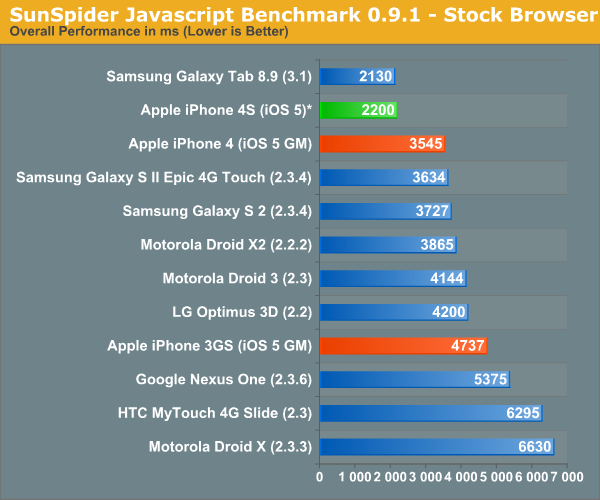

Using some of the integer and fp tests of published Geekbench scores we can already conclude that Apple is shipping a lower clocked A5 in the iPhone 4S than it does in the iPad 2. This naturally makes sense as the iPhone 4S has a much smaller 5.25 Whr battery. Based on the Geekbench results it looks like the iPad 2 is clocked around 25% higher than the iPhone 4S, pegging the latter's clock speed at 800MHz.
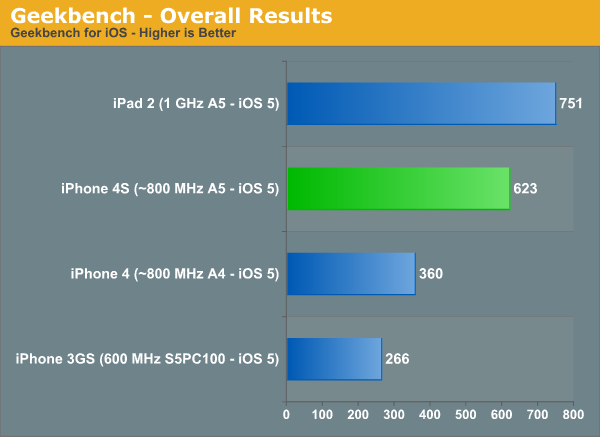
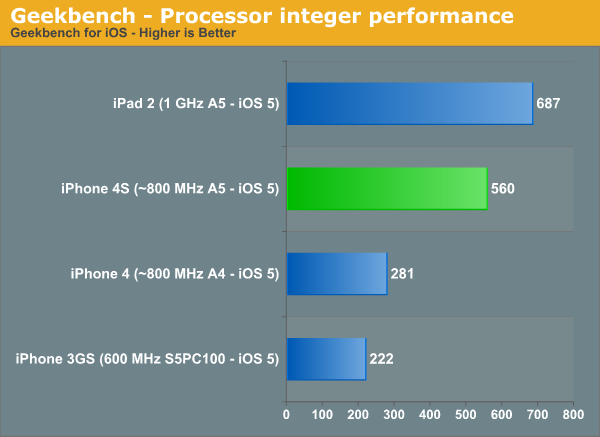
A lower clock not only means higher yields from the factory, but likely a lower operating voltage as well. Dropping a CPU's core voltage, yields a greater-than-linear decrease in power consumption, making the marginal loss in clock speed a good choice. At a lower operating frequency than its Android competitors, Apple does have to exploit its strengths in software to avoid any tangible performance penalties. Apple has traditionally done this very well in the past, so I don't expect the loss of frequency to be a huge deal to the few who do cross-shop iOS and Android.
Unsurprisingly, memory bandwidth doesn't appear to have gone up either compared to the iPad 2's A5 (taking into account scaling due to CPU clock increases). The Samsung part number on the iPad 2's A5 indicates two LPDDR2-800 die on package, it's safe to assume that whatever Apple clocked the memory interface at in the iPad 2 remains unchanged in the iPhone 4S.
The GPU results tell a similar story courtesy of some early GLBenchmark 2.1 results. The 960 x 640 results are useless as they are bound by vsync at ~60 fps. Luckly GLBenchmark 2.1 added an off-screen render mode at 1280 x 720 where we can really see the differences between the iPad 2 and iPhone 4S A5 implementations:
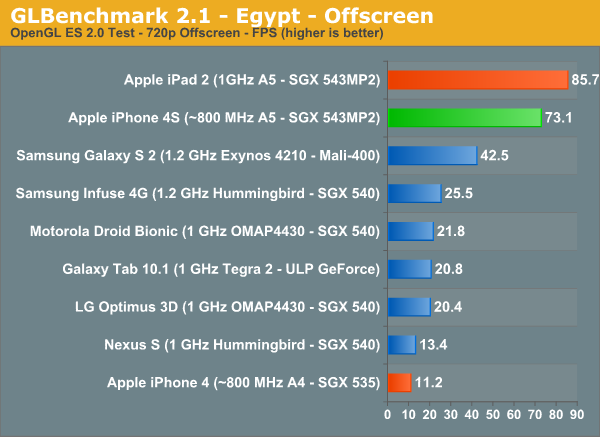
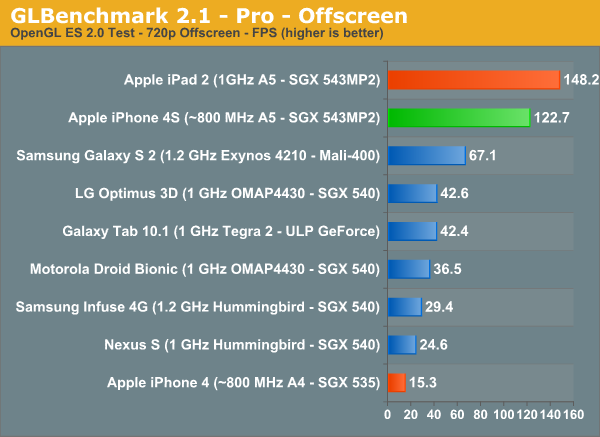
Here the iPad 2 holds a ~21% performance advantage, which once again I assume to be all related to clock speed. Also note the huge advantage over the existing iPhone 4. The GPU power in the 4S should be more than enough to run any well written, current generation title at well north of 30 fps on its display.
We'll be reviewing the iPhone 4S in the coming weeks, stay tuned!
Source: GLBenchmark Database, Geekbench Database, Macrumors










216 Comments
View All Comments
Paulman - Tuesday, October 11, 2011 - link
The iOS5 improvement for the iPhone 3GS is ridiculous! The SunSpider bench completes in less than 50% of the original time. Wow. The iPhone 4 gains are impressive as well.- "I suspect Ice Cream Sandwich will bridge the Android smartphone gap."
Hmmm... I wonder how big that jump will be. And I wonder if the Samsung Galaxy S II (and variants) will be getting the Ice Cream Sandwich update anytime soon (after Google releases it)...
JasonInofuentes - Tuesday, October 11, 2011 - link
It's up to the chipset manufacturers to manage the ports of Android variants to their respective chipset. This typically doesn't take a long time, though with Honeycomb we seemed to wait an awfully long time, and are only now starting to see non-Tegra 2 tablets roll out. With any luck ICS will get ported to all the SoCs on the market quickly, and then, unfortunately, it's up to the individual device manufacturer's to implement them and then the carriers to validate them. Sigh. It could be a while.B3an - Tuesday, October 11, 2011 - link
I expect Ice Cream Sandwich to easily put the android phones ahead for javascript performance. As even a slower Tegra 2 with Android 3.1 can atleast match the 4S here. The Samsung GSII will take the lead once its gets ICS.No idea if ICS will help much with GPU performance though.
steven75 - Tuesday, October 11, 2011 - link
Has Samsung gone on record that they will provide ICS for the GSII? We all know how this story goes on Android...Bozzified - Tuesday, October 11, 2011 - link
Samsung is fairly good at keeping it up to date, at least in my experience. They update SGS2 with the latest Android maybe a few weeks after an official SDK is released.michael2k - Tuesday, October 11, 2011 - link
I guess it depends on how you define "good". They're still releasing Gingerbread updates to their Galaxy S (a 19 month old phone), which is good, but this is still 10 months after Gingerbread was released (which is bad).ph00ny - Tuesday, October 11, 2011 - link
It's hard to comment on things when outside of carrier branded ones are updated to gingerbread much earlierAnandReader1999 - Wednesday, October 12, 2011 - link
In Canada, we get our updates much faster than the USA. It's unfortunate that you guys are restricted so much by your carrier's, but it has nothing to do with Android or the phone manufacturer in most cases...just USA's carriers.Paulman - Sunday, October 16, 2011 - link
Really, we do? Sweet! Hopefully that bodes well for the Galaxy S II LTE that will be released here by Rogers in Canada (soon). It's looking more and more like that will be my new phone (as opposed to the iPhone 4S) and it would be very much appreciated if/when ICS comes in for that model :Pmwarner1 - Thursday, October 13, 2011 - link
The following firmwares have been released in Europe for the Galaxy S. As has been pointed out, this is a US carrier issue and not a Samsung issue - Samsung are generally very good indeed at regular firmware updates:Firmware Android Date
I9000XXJE2 2.1 2010 May
I9000XXJE3 2.1 2010 May
I9000XXJE5 2.1 2010 May
I9000XXJE6 2.1 2010 May
I9000XXJE7 2.1 2010 May
I9000XXJE9 2.1 2010 May
I9000XXJEC 2.1 2010 May
I9000XXJF1 2.1 2010 June
I9000XXJF2 2.1 2010 June
I9000XXJF3 2.1 2010 June
I9000XXJF7 2.1 2010 June
I9000XXJFB 2.1 2010 June
I9000XWJFD 2.1 2010 June
I9000XWJFF 2.1 2010 June
I9000XWJG1 2.1 2010 July
I9000XWJG3 2.1 2010 July
I9000XWJG5 2.1 2010 July
I9000XWJM1 2.1 2010 July
I9000XWJM1 # 2.1 2010 July
I9000XWJM2 ## 2.1 2010 July
I9000XWJM5 # 2.1 2010 July
I9000XWJM6 ## 2.1 2010 August
I9000XWJM7 ## 2.1 2010 August
I9000XWJM8 ## 2.1 2010 August
I9000XXJP1 # 2.2 2010 August
I9000XXJP2 # 2.2 2010 August
I9000XXJP3 # 2.2 2010 August
I9000XXJPC ## 2.2 2010 August
I9000XXJPH ## 2.2 2010 September
I9000XXJPK ## 2.2 2010 September
I9000XWJM9 ## 2.1 2010 September
I9000XWJP6 ## 2.2 2010 October
I9000XXJPM ## 2.2 2010 October
I9000XXJPO ## 2.2 2010 October
I9000XWJPA ## 2.2 2010 October
I9000XWJPA ## 2.2 2010 October
I9000XFJP7 ## 2.2 2010 October
I9000XWJPB ## 2.2 2010 October
I9000XFJP9 ## 2.2 2010 November
I9000XXJPI ## 2.2 2010 December
I9000XXJPU ## 2.2.1 2010 December
I9000XXJPX ## 2.2.1 2010 December
I9000XXJPY ## 2.2.1 2010 December
I9000XWJS3 ## 2.2.1 2011 January
I9000XWJS3 ## 2.2.1 2011 January
I9000XFJS2 ## 2.2.1 2011 January
I9000XWJS5 ## 2.2.1 2011 January
I9000XWJS5 ## 2.2.1 2011 January
I9000XXJQ3 ## 2.2.1 2011 January
I9000RSJS2 ## 2.2.1 2011 January
I9000XWJS7 ## 2.2.1 2011 February
I9000XWJV1 ## 2.3.2 2011 February
I9000XWJS8 ## 2.2.1 2011 March
I9000XXJVK ## 2.3.3 2011 March
I9000XWJVA ## 2.3.3 2011 April 4
I9000XWJVB ## 2.3.3 2011 April 8
I9000XWJVB ## 2.3.3 2011 April 8
I9000XWJVB ## 2.3.3 2011 April 8
I9000XWJSD ## 2.2.1 2011 May 2
I9000XWJVH ## 2.3.3 2011 May 4
I9000XWJVH ## 2.3.3 2011 May 4
I9000XWJVH ## 2.3.3 2011 May 4
I9000XWJVH ## 2.3.3 2011 May 4
I9000XXJVO ## 2.3.3 2011 May 4
I9000XWJVH ## 2.3.3 2011 May 4
I9000XWJVH ## 2.3.3 2011 May 4
I9000XWJVI ## 2.3.3 2011 May 14
I9000XXJVP ## 2.3.4 2011 June 3
I9000XXJVQ ## 2.3.4 2011 June 10
I9000XXJVR ## 2.3.4 2011 July 27
I9000XXJVR ## 2.3.4 2011 July 27
I9000XXJVS ## 2.3.5 2011 September 8